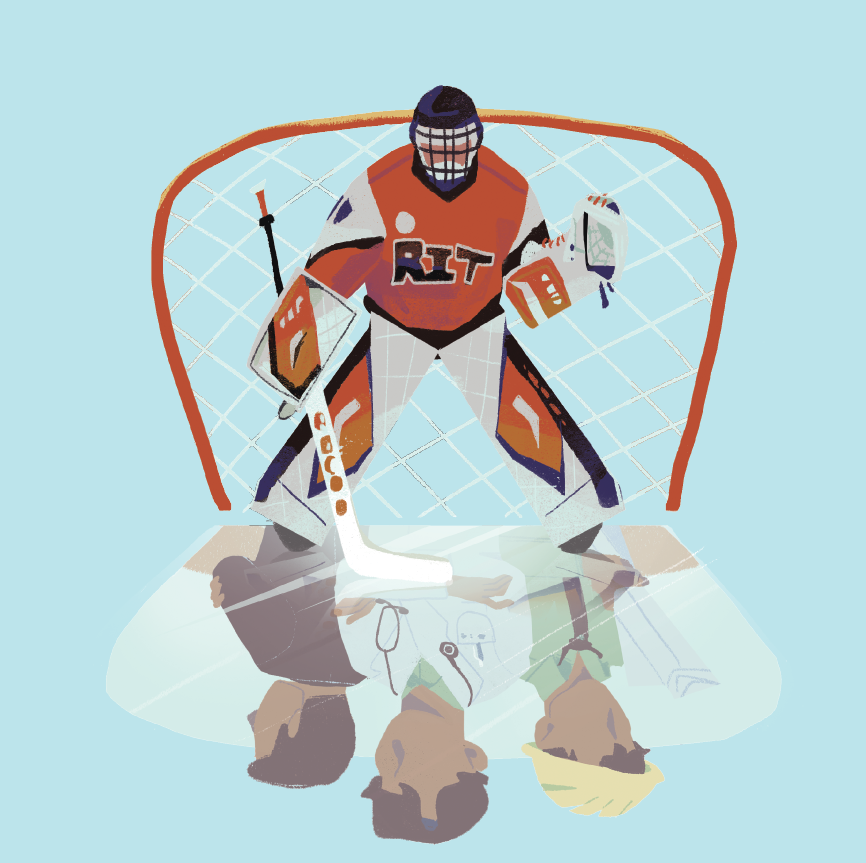Hockey's Mark on RIT
by Frankie Albin and Rozie Yeghiazarian | published Feb. 2nd, 2018
“RIT hockey is a part of the culture of the school ... it’s something that we like to show off. Obviously being the only Division I sport on campus is pretty special as it is, but I think it really highlights the school as something more than just academics,” said Madison Farrand, a second year Mechanical Engineering major and member of the RIT women’s hockey team.
Why Hockey?
Hockey was almost always a natural component of RIT, given the school's proximity to Canada as well as its later possession of an arena. There aren’t very many universities in the U.S. that have hockey arenas, let alone two of them. Frank Ritter Arena, the first of RIT’s arenas, was actually a gift from ice skating enthusiast Frank Ritter Shumway when RIT first moved to its Henrietta, N.Y. campus.
RIT always had a club hockey team, even when the campus was located downtown. After this new ice rink was built however, a larger-scale hockey program was an obvious next step.
“The question was, 'Why don’t we use this resource to build a hockey program and make an impact?' It was natural,” said Lou Spiotti, executive director of Intercollegiate Athletics.
RIT then pushed forward plans to strengthen both the hockey program and the entire athletic program. By 1983, RIT’s new hockey team was winning national championships.
In 2005, RIT applied to becomea Division I team. It was a success, and hockey at RIT went on to become what it is today.
What About Academics?
“We’re attracting the kind of student and the kind of student athlete RIT wants: an accomplished person in the classroom and an accomplished person in the game,” Spiotti said.
RIT’s main focus for its student athletes is not for them to solely emphasize athletics, but for them to graduate and go on to be successful professionals in their field as well.
This starts with the coaches, who recruit only the students they think can make it at RIT academically, as well as athletically.
These considerations and processes have proven very successful. Out of the approximately 650 recent student athletes, Spiotti noted that not one had become ineligible to play because of academics.
Last year, student athletes at RIT had an average GPA of 3.32, much higher than the student population in general.
Student athletes face a GPA requirement to be eligible to play in the NCAA, but the academic ambition of student athletes does not stop there.
“We strive to have the highest GPA as best we can,” Farrand said. “You don’t have a lot of time to mess around and not get everything done ... being a Division I athlete you have a really busy schedule ... [but] it’s all worth it in the end and I think we’re all on the same page about that.”
While some RIT student athletes go on and sign professional contracts in their respective sport, it is not typical.
Students come to RIT because they want a degree, and for that reason RIT athletics staff put that goal first. Students don’t come to RIT and then leave in the middle to go play professional sports. They want to leave RIT not only with athletic prowess, but also with a degree, practical skills and knowledge in their field.
“It’s the best of both worlds. We don’t talk about professional sports with our athletes, we talk about academics first,” said Spiotti.
“It’s the best of both worlds. We don’t talk about professional sports with our athletes, we talk about academics first,” said Spiotti.
Building the Brand
“There is nothing more impactful than going down to Blue Cross Arena when there’s 11,000 students wearing orange,” Spiotti explained.
“There is nothing more impactful than going down to Blue Cross Arena when there’s 11,000 students wearing orange,” Spiotti explained.
Coaches for all of RIT’s sports actually bring their recruits to the hockey game during homecoming weekend to show them what RIT is all about.
The electric atmosphere of the games was not always like this,not even a little over two decades ago. Previously, RIT culture was more solely focused on academics, but now it is this blend of academics and athletics that modern RIT students are very familiar with.
“The uniqueness of RIT is the blend of the student and the athlete,” Spiotti noted.
Branding also extends to external leagues as well as to other teams that RIT competes against. Both the men and women’s hockey teams compete against some other great teams with very well-established brands – Syracuse University, University of Rochester, Penn State and many more. RIT going head-to-head with these other well established teams only furthers its own brand and its prominence on the rink.
How are the teams doing?
While Farrand notes a more-than-usual number of injuries recently, Spiotti says this past year has been one of the best athletic years RIT has ever had. The men’s hockey team, for example, beat the number 9 team in the nation, Providence College, late last semester.
“I think we have a bright future, we just gotta get there. It’s gonna take a lot more hard work but we’re on the right path,” Farrand said.
Both Farrand and Spiotti concluded with high hopes and ambition for the coming games as well as the future of hockey at RIT, and that the



